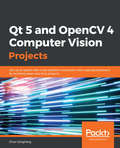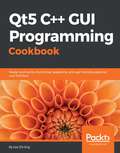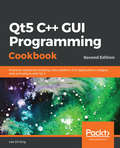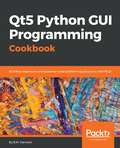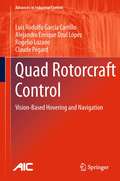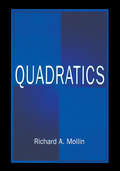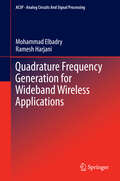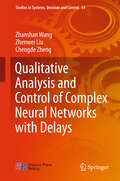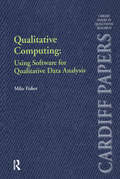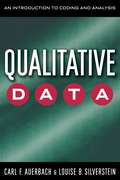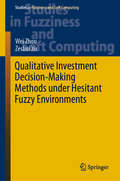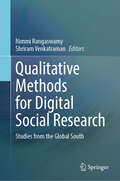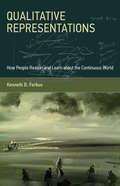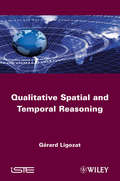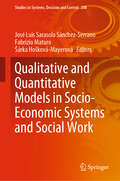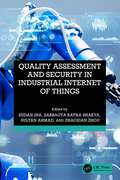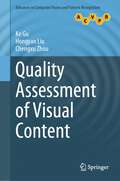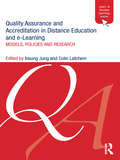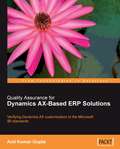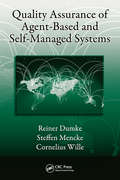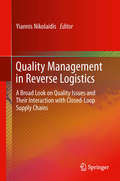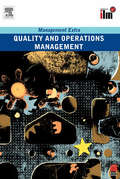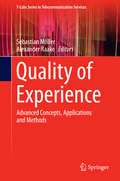- Table View
- List View
Qt 5 and OpenCV 4 Computer Vision Projects: Get up to speed with cross-platform computer vision app development by building seven practical projects
by Zhuo QingliangCreate image processing, object detection and face recognition apps by leveraging the power of machine learning and deep learning with OpenCV 4 and Qt 5. Key Features: Gain practical insights into code for all projects covered in this book; Understand modern computer vision concepts such as character recognition, image processing and modification; Learn to use a graphics processing unit (GPU) and its parallel processing power for filtering images quickly. Book Description: OpenCV and Qt have proven to be a winning combination for developing cross-platform computer vision applications. By leveraging their power, you can create robust applications with both an intuitive graphical user interface (GUI) and high-performance capabilities. This book will help you learn through a variety of real-world projects on image processing, face and text recognition, object detection, and high-performance computing. You’ll be able to progressively build on your skills by working on projects of increasing complexity.You’ll begin by creating an image viewer application, building a user interface from scratch by adding menus, performing actions based on key-presses, and applying other functions. As you progress, the book will guide you through using OpenCV image processing and modification functions to edit an image with filters and transformation features. In addition to this, you’ll explore the complex motion analysis and facial landmark detection algorithms, which you can use to build security and face detection applications. Finally, you’ll learn to use pretrained deep learning models in OpenCV and GPUs to filter images quickly. By the end of this book, you will have learned how to effectively develop full-fledged computer vision applications with OpenCV and Qt. What you will learn: Create an image viewer with all the basic requirements; Construct an image editor to filter or transform images; Develop a security app to detect movement and secure homes; Build an app to detect facial landmarks and apply masks to faces; Create an app to extract text from scanned documents and photos; Train and use cascade classifiers and DL models for object detection; Build an app to measure the distance between detected objects; Implement high-speed image filters on GPU with Open Graphics Library (OpenGL). Who this book is for: This book is for engineers and developers who are familiar with both Qt and OpenCV frameworks and are capable of creating simple projects using them, but want to build their skills to create professional-level projects using them. Familiarity with the C++ language is a must to follow the example source codes in this book.
Qt5 C++ GUI Programming Cookbook
by Lee Zhi EngUse Qt5 to design and build a graphical user interface that is functional, appealing, and user-friendly for your software application About This Book * Learn to make use of Qt5 to design and customize the look-and-feel of your application * Improve the visual quality of your application by utilizing the graphic rendering system and animation system provided by Qt5 * A good balance of visual presentation and its contents will make an application appealing yet functional Who This Book Is For This book intended for those who want to develop software using Qt5. If you want to improve the visual quality and content presentation of your software application, this book is best suited to you. What You Will Learn * Customize the look and feel of your application using the widget editor provided by Qt5 * Change the states of the GUI elements to make them appear in a different form * Animating the GUI elements using the built-in animation system provided by Qt5 * Draw shapes and 2D images in your application using Qt5's powerful rendering system * Draw 3D graphics in your application by implementing OpenGL, an industry-standard graphical library to your project * Build a mobile app that supports touch events and export it to your device * Parse and extract data from an XML file, then present it on your software's GUI * Display web content on your program and interact with it by calling JavaScript functions from C++, or calling C++ functions from the web content * Access to MySQL and SQLite databases to retrieve data and display it on your software's GUI In Detail With the advancement of computer technology, the software market is exploding with tons of software choices for the user, making their expectations higher in terms of functionality and the look and feel of the application. Therefore, improving the visual quality of your application is vital in order to overcome the market competition and stand out from the crowd. This book will teach you how to develop functional and appealing software using Qt5 through multiple projects that are interesting and fun. This book covers a variety of topics such as look-and-feel customization, GUI animation, graphics rendering, implementing Google Maps, and more. You will learn tons of useful information, and enjoy the process of working on the creative projects provided in this book. Style and approach This book focuses on customizing the look and feel and utilizing the graphical features provided by Qt5. It takes a step-by-step approach, providing tons of screenshots and sample code for you to follow and learn. Each topic is explained sequentially and placed in context.
Qt5 C++ GUI Programming Cookbook: Practical recipes for building cross-platform GUI applications, widgets, and animations with Qt 5
by Lee Zhi Eng<p>Use Qt 5 to design and build functional, appealing, and user-friendly graphical user interfaces (GUIs) for your applications. <p>Key Features: <p> <li>Learn to use Qt 5 to design and customize the look and feel of your application <li>Improve the visual quality of an application by using graphics rendering and animation <li>Understand the balance of presentation and web content that will make an application appealing yet functional</li> <p> <p>Book Description: <p>With the growing need to develop GUIs for multiple targets and multiple screens, improving the visual quality of your application becomes important so that it stands out from your competitors. With its cross-platform ability and the latest UI paradigms, Qt makes it possible to build intuitive, interactive, and user-friendly user interfaces for your applications. <p>Qt5 C++ GUI Programming Cookbook, Second Edition teaches you how to develop functional and appealing user interfaces using the latest version of QT5 and C++.This book will help you learn a variety of topics such as GUI customization and animation, graphics rendering, implementing Google Maps, and more. You will also be taken through advanced concepts like asynchronous programming, event handling using signals and slots, network programming, various aspects of optimizing your application. <p>By the end of the book, you will be confident to design and customize GUI applications that meet your clients' expectations and have an understanding of best practice solutions for common problems. <p>What you will learn: <p> <li>Animate GUI elements using Qt5's built-in animation system <li>Draw shapes and 2D images using Qt5's powerful rendering system <li>Implement an industry-standard OpenGL library in your project <li>Build a mobile app that supports touch events and exports it onto devices <li>Parse and extract data from an XML file and present it on your GUI <li>Interact with web content by calling JavaScript functions from C++ <li>Access MySQL and SQLite databases to retrieve data and display it on your GUI</li> <p> <p>Who this book is for: This intermediate-level book is designed for those who want to develop software using Qt 5. If you want to improve the visual quality and content presentation of your software application, this book is for you. Prior experience of C++ programming is required.</p>
Qt5 Python GUI Programming Cookbook: Building responsive and powerful cross-platform applications with PyQt
by B. M. HarwaniOver 60 recipes to help you design interactive, smart, and cross-platform GUI applicationsKey Features Get succinct QT solutions to pressing GUI programming problems in Python Learn how to effectively implement reactive programming Build customized applications that are robust and reliableBook DescriptionPyQt is one of the best cross-platform interface toolkits currently available; it's stable, mature, and completely native. If you want control over all aspects of UI elements, PyQt is what you need. This book will guide you through every concept necessary to create fully functional GUI applications using PyQt, with only a few lines of code.As you expand your GUI using more widgets, you will cover networks, databases, and graphical libraries that greatly enhance its functionality. Next, the book guides you in using Qt Designer to design user interfaces and implementing and testing dialogs, events, the clipboard, and drag and drop functionality to customize your GUI. You will learn a variety of topics, such as look and feel customization, GUI animation, graphics rendering, implementing Google Maps, and more. Lastly, the book takes you through how Qt5 can help you to create cross-platform apps that are compatible with Android and iOS. You will be able to develop functional and appealing software using PyQt through interesting and fun recipes that will expand your knowledge of GUIsWhat you will learn Use basic Qt components, such as a radio button, combo box, and sliders Use QSpinBox and sliders to handle different signals generated on mouse clicks Work with different Qt layouts to meet user interface requirements Create custom widgets and set up customizations in your GUI Perform asynchronous I/O operations and thread handling in the Python GUI Employ network concepts, internet browsing, and Google Maps in UI Use graphics rendering and implement animation in your GUI Make your GUI application compatible with Android and iOS devicesWho this book is forIf you’re an intermediate Python programmer wishing to enhance your coding skills by writing powerful GUIs in Python using PyQT, this is the book for you.
Quad Rotorcraft Control
by Rogelio Lozano Claude Pégard Luis Rodolfo García Carrillo Alejandro Enrique Dzul LópezQuad Rotorcraft Control develops original control methods for the navigation and hovering flight of an autonomous mini-quad-rotor robotic helicopter. These methods use an imaging system and a combination of inertial and altitude sensors to localize and guide the movement of the unmanned aerial vehicle relative to its immediate environment. The history, classification and applications of UAVs are introduced, followed by a description of modelling techniques for quad-rotors and the experimental platform itself. A control strategy for the improvement of attitude stabilization in quad-rotors is then proposed and tested in real-time experiments. The strategy, based on the use low-cost components and with experimentally-established robustness, avoids drift in the UAV's angular position by the addition of an internal control loop to each electronic speed controller ensuring that, during hovering flight, all four motors turn at almost the same speed. The quad-rotor's Euler angles being very close to the origin, other sensors like GPS or image-sensing equipment can be incorporated to perform autonomous positioning or trajectory-tracking tasks. Two vision-based strategies, each designed to deal with a specific kind of mission, are introduced and separately tested. The first stabilizes the quad-rotor over a landing pad on the ground; it extracts the 3-dimensional position using homography estimation and derives translational velocity by optical flow calculation. The second combines colour-extraction and line-detection algorithms to control the quad-rotor's 3-dimensional position and achieves forward velocity regulation during a road-following task. In order to estimate the translational-dynamical characteristics of the quad-rotor (relative position and translational velocity) as they evolve within a building or other unstructured, GPS-deprived environment, imaging, inertial and altitude sensors are combined in a state observer. The text give the reader a current view of the problems encountered in UAV control, specifically those relating to quad-rotor flying machines and it will interest researchers and graduate students working in that field. The vision-based control strategies presented help the reader to a better understanding of how an imaging system can be used to obtain the information required for performance of the hovering and navigation tasks ubiquitous in rotored UAV operation.
Quadratics (Discrete Mathematics and Its Applications #2)
by Richard A. MollinThe first thing you will find out about this book is that it is fun to read. It is meant for the browser, as well as for the student and for the specialist wanting to know about the area. The footnotes give an historical background to the text, in addition to providing deeper applications of the concept that is being cited. This allows the browser to look more deeply into the history or to pursue a given sideline. Those who are only marginally interested in the area will be able to read the text, pick up information easily, and be entertained at the same time by the historical and philosophical digressions. It is rich in structure and motivation in its concentration upon quadratic orders.This is not a book that is primarily about tables, although there are 80 pages of appendices that contain extensive tabular material (class numbers of real and complex quadratic fields up to 104; class group structures; fundamental units of real quadratic fields; and more!). This book is primarily a reference book and graduate student text with more than 200 exercises and a great deal of hints! The motivation for the text is best given by a quote from the Preface of Quadratics: "There can be no stronger motivation in mathematical inquiry than the search for truth and beauty. It is this author's long-standing conviction that number theory has the best of both of these worlds. In particular, algebraic and computational number theory have reached a stage where the current state of affairs richly deserves a proper elucidation. It is this author's goal to attempt to shine the best possible light on the subject."
Quadrature Frequency Generation for Wideband Wireless Applications
by Ramesh Harjani Mohammad ElbadryThis book describes design techniques for wideband quadrature LO generation for software defined radio transceivers, with frequencies spanning 4GHz to around 80GHz. The authors discuss several techniques that can be used to reduce the cost and/or power consumption of one of the key component of the RF front-end, the quadrature local oscillator. The discussion includes simple and useful insights into quadrature VCOs, along with numerous examples of practical techniques.
Qualitative Analysis and Control of Complex Neural Networks with Delays
by Zhanshan Wang Zhenwei Liu Chengde ZhengThis book focuses on the stability of the dynamical neural system, synchronization of the coupling neural system and their applications in automation control and electrical engineering. The redefined concept of stability, synchronization and consensus are adopted to provide a better explanation of the complex neural network. Researchers in the fields of dynamical systems, computer science, electrical engineering and mathematics will benefit from the discussions on complex systems. The book will also help readers to better understand the theory behind the control technique and its design.
Qualitative Computing: Using Software for Qualitative Data Analysis (Cardiff Papers in Qualitative Research)
by Mike FisherAs qualitative researchers incorporate computer assistance into their analytic approaches, important questions arise about the adoption of new technology. Is it worth learning computer-assisted methods? Will the pay-off be sufficient to justify the investment? Which programs are worth learning? What are the effects on the analysis process? This book complements the existing literature by giving a detailed account of the use of four major programs in analyzing the same data. Priority is given to the tasks of qualitative analysis rather than to program capability and the programs are treated as tools rather than as a discipline to be acquired. The key is not what the programs allow researcher to do, but whether the tasks that researchers need to undertake are facilitated by the software. Thus the study develops a user-centred approach to the adoption of computer-assisted qualitative data analysis. The author emphasises qualitative analysis as a creative craft, but one which must increasingly be subject to rigorous methodological scrutiny. The adoption of computer-aided methods offers opportunities, but also dangers and ultimately this book is about the scientific qualitative research. Written in a distinctive and succinct style, this book will be valuable to social science researchers and students interested in qualitative research and in the potential for computer-assisted analysis.
Qualitative Data: An Introduction to Coding and Analysis (Qualitative Studies in Psychology #21)
by Carl Auerbach Louise B SilversteinA step-by-step guide to the qualitative research process that &“can be understood by beginners . . . informative and interesting&” (Choice).Qualitative Data is meant for the novice researcher who needs guidance on what specifically to do when faced with a sea of information. It takes readers through the qualitative research process, beginning with an examination of the basic philosophy of qualitative research, and ending with planning and carrying out a qualitative research study. It provides an explicit, step-by-step procedure that will take the researcher from the raw text of interview data through data analysis and theory construction to the creation of a publishable work. The volume provides actual examples based on the authors&’ own work, including two published pieces in the appendix, so that readers can follow examples for each step of the process, from the project&’s inception to its finished product. It also includes an appendix explaining how to implement these data analysis procedures using NVIVO, a qualitative data analysis program.
Qualitative GIS: A Mixed Methods Approach
by Sarah Elwood Meghan CopeGeographic Information Systems are an essential tool for analyzing and representing quantitative spatial data. Qualitative GIS explains the recent integration of qualitative research with Geographical Information Systems With a detailed contextualising introduction, the text is organised in three sections: Representation: examines how researchers are using GIS to create new types of representations; working with spatial data, maps, and othervisualizations to incorporate multiple meanings and to provide texture and context. Analysis: discusses the new techniques of analysis that are emerging at the margins between qualitative research and GIS, this in the wider context of a critical review of mixed-methods in geographical research Theory: questions how knowledge is produced, showing how ideas of 'science' and 'truth' inform research, and demonstrates how qualitative GIS can be used to interrogate discussions of power, community, and social action Making reference to representation, analysis, and theory throughout, the text shows how to frame questions, collect data, analyze results, and represent findings in a truly integrated way. An important addition to the mixed methods literature, Qualitative GIS will be the standard reference for upper-level students and researchers using qualitative methods and Geographic Information Systems.
Qualitative Investment Decision-Making Methods under Hesitant Fuzzy Environments (Studies in Fuzziness and Soft Computing #376)
by Wei Zhou Zeshui XuThis book describes five qualitative investment decision-making methods based on the hesitant fuzzy information. They are: (1) the investment decision-making method based on the asymmetric hesitant fuzzy sigmoid preference relations, (2) the investment decision-making method based on the hesitant fuzzy trade-off and portfolio selection, (3) the investment decision-making method based on the hesitant fuzzy preference envelopment analysis, (4) the investment decision-making method based on the hesitant fuzzy peer-evaluation and strategy fusion, and (5) the investment decision-making method based on the EHVaR measurement and tail analysis.
Qualitative Methods for Digital Social Research: Studies from the Global South
by Nimmi Rangaswamy Shriram VenkatramanThis volume offers a series of practical methods to study digital behaviours considering the socio-cultural realities of the global south. It includes methodologically rigorous applied research chapters from leading international researchers offering information on gold mines and blind spots in researching the digital in the global south. It develops a tri-sectional format based on distinct areas of research, geographical variability and diversity of methods and approaches. The first section focuses on Dissecting Research Fractures – which disrupts the established research ideologies and practices, user behaviors, theoretical perspectives, and field methods in the study of digital social research . The second section on Innovating Methods proposes and extends mixed methodologies that go beyond research boundaries to produce novel possibilities for study. The final section on Re-Imagining the Field breaks new ground in exploring the social-digital where a transient research field is contextualized and stabilized through the social, infrastructural, and digital interweaving. The book offers the reader an inside view of studying marginal yet emerging users and consumers of digital technologies. The three sections together purport to draw textual, graphical, temporal, and ethnographic insights via innovative and hybrid observational tools to record, annotate and formulate everyday experiences of digital life. The volume addresses scholars interested in hybridizing methods, early career researchers, and graduates working on connecting humans and digital technologies. It also holds considerable appeal for digital marketers and strategists, offering practically applicable methods to study digital life.
Qualitative Representations: How People Reason and Learn about the Continuous World
by Kenneth D. ForbusAn argument that qualitative representations—symbolic representations that carve continuous phenomena into meaningful units—are central to human cognition.In this book, Kenneth Forbus proposes that qualitative representations hold the key to one of the deepest mysteries of cognitive science: how we reason and learn about the continuous phenomena surrounding us. Forbus argues that qualitative representations—symbolic representations that carve continuous phenomena into meaningful units—are central to human cognition. Qualitative representations provide a basis for commonsense reasoning, because they enable practical reasoning with very little data; this makes qualitative representations a useful component of natural language semantics. Qualitative representations also provide a foundation for expert reasoning in science and engineering by making explicit the broad categories of things that might happen and enabling causal models that help guide the application of more quantitative knowledge as needed. Qualitative representations are important for creating more human-like artificial intelligence systems with capabilities for spatial reasoning, vision, question answering, and understanding natural language.Forbus discusses, among other topics, basic ideas of knowledge representation and reasoning; qualitative process theory; qualitative simulation and reasoning about change; compositional modeling; qualitative spatial reasoning; and learning and conceptual change. His argument is notable both for presenting an approach to qualitative reasoning in which analogical reasoning and learning play crucial roles and for marshaling a wide variety of evidence, including the performance of AI systems. Cognitive scientists will find Forbus's account of qualitative representations illuminating; AI scientists will value Forbus's new approach to qualitative representations and the overview he offers.
Qualitative Spatial and Temporal Reasoning
by Gérard LigozatStarting with an updated description of Allen's calculus, the book proceeds with a description of the main qualitative calculi which have been developed over the last two decades. It describes the connection of complexity issues to geometric properties. Models of the formalisms are described using the algebraic notion of weak representations of the associated algebras. The book also includes a presentation of fuzzy extensions of qualitative calculi, and a description of the study of complexity in terms of clones of operations.
Qualitative and Quantitative Models in Socio-Economic Systems and Social Work (Studies in Systems, Decision and Control #208)
by Šárka Hošková-Mayerová Fabrizio Maturo José Luis Sarasola Sánchez-SerranoThe main purpose of this book is not only to present recent studies and advances in the field of social science research, but also to stimulate discussion on related practical issues concerning statistics, mathematics, and economics. Accordingly, a broad range of tools and techniques that can be used to solve problems on these topics are presented in detail in this book, which offers an ideal reference work for all researchers interested in effective quantitative and qualitative tools. The content is divided into three major sections. The first, which is titled “Social work”, collects papers on problems related to the social sciences, e.g. social cohesion, health, and digital technologies. Papers in the second part, “Education and teaching issues,” address qualitative aspects, education, learning, violence, diversity, disability, and ageing, while the book’s final part, “Recent trends in qualitative and quantitative models for socio-economic systems and social work”, features contributions on both qualitative and quantitative issues. The book is based on a scientific collaboration, in the social sciences, mathematics, statistics, and economics, among experts from the “Pablo de Olavide” University of Seville (Spain), the “University of Defence” of Brno (Czech Republic), the “G. D’Annunzio” University of Chieti-Pescara (Italy) and “Alexandru Ioan Cuza University” of Iaşi (Romania). The contributions, which have been selected using a peer-review process, examine a wide variety of topics related to the social sciences in general, while also highlighting new and intriguing empirical research conducted in various countries. Given its scope, the book will appeal, in equal measure, to sociologists, mathematicians, statisticians and philosophers, and more generally to scholars and specialists in related fields.
Quality Assessment and Security in Industrial Internet of Things
by Sudan Jha Sultan Ahmad Sarbagya Ratna Shakya Zhaoxian ZhouThis book highlights authentication and trust evaluation models in the Industrial Internet of Things. It further discusses data breaches and security issues in various Artificial Intelligence-enabled systems and uses Blockchain to resolve the challenges faced by the Industrial Internet of Things. The text showcases performance quality assessment for the Industrial Internet of Things’ applications.This book: Discusses and evaluates different quality assessment systems and authentication of smart devices Addresses data handling, data security, confidentiality, and integrity of data in the Industrial Internet of Things Focuses on developing framework and standardization of quality assessment for diverse Internet of Things-enabled devices Explains the designing, developing, and framing of smart machines, that are equipped with tools for tracking and logging data to provide advanced security features Presents the convergence of the Internet of Things toward Industry 4.0 through quality assessment via analyzing data security and identifying vulnerabilities It is primarily written for graduate students and academic researchers in the fields of electrical engineering, electronics, and communications engineering, industrial and production engineering, computer science, and engineering.
Quality Assessment of Visual Content (Advances in Computer Vision and Pattern Recognition)
by Hongyan Liu Ke Gu Chengxu ZhouThis book provides readers with a comprehensive review of image quality assessment technology, particularly applications on screen content images, 3D-synthesized images, sonar images, enhanced images, light-field images, VR images, and super-resolution images. It covers topics containing structural variation analysis, sparse reference information, multiscale natural scene statistical analysis, task and visual perception, contour degradation measurement, spatial angular measurement, local and global assessment metrics, and more. All of the image quality assessment algorithms of this book have a high efficiency with better performance compared to other image quality assessment algorithms, and the performance of these approaches mentioned above can be demonstrated by the results of experiments on real-world images. On the basis of this, those interested in relevant fields can use the results obtained through these quality assessment algorithms for further image processing. The goal of this book is to facilitate the use of these image quality assessment algorithms by engineers and scientists from various disciplines, such as optics, electronics, math, photography techniques and computation techniques. The book can serve as a reference for graduate students who are interested in image quality assessment techniques, for front-line researchers practicing these methods, and for domain experts working in this area or conducting related application development.
Quality Assurance and Accreditation in Distance Education and e-Learning: Models, Policies and Research (Open and Flexible Learning Series)
by Insung Jung Colin LatchemQuality assurance (QA) in open and distance learning (ODL) can be a contentious issue. Some argue that it should be judged by the same criteria and methods as face-to-face education, while others claim that it is so different in its organization, enrolments and operations that conventional QA mechanisms cannot apply. Some advocate the use of specific guidelines and standards for e-learning; others believe that, regardless of the technology, the basic principles of quality teaching and learning should apply. Providers who have enjoyed freedom from external scrutiny may resist attempts at external regulation and auditing and look upon QA as yet another imposition of corporatization and bureaucracy on education. Others see it as a means of establishing a culture of quality, self-reflection and self-improvement. There is little research-based literature to guide policy-makers, managers and practitioners in applying QA in education and training to ensure the right balance is found between accountability and autonomy, as well as assuring quality for the time and costs involved. In this respect, Quality Assurance and Accreditation in Distance Education and e-Learning is a book that is long overdue. It explains what is involved in QA and accreditation in education. It describes and analyzes applications of these practices in open, distance, dual-mode and conventional universities throughout Europe, North America, Africa, and the Asia-Pacific, looking at open schooling, e-learning in conventional schools, non-formal adult and community education, and corporate and small-to-medium enterprises. Quality Assurance and Accreditation in Distance Education and e-Learning is edited and authored by experts with extensive international experience in ODL, e-learning and QA who give careful consideration to the possibilities and challenges involved. The book will be an invaluable guide for all policy-makers, managers, practitioners and researchers in the field.
Quality Assurance for Dynamics AX-Based ERP Solutions
by Anil Kumar GuptaThis book deals with quality awareness as well as quality assurance. It discusses the quality expectations from the ERP solution, talks about the best practices for meeting the quality expectations, and then suggests the strategies to test the customized Dynamics AX ERP application. Microsoft Business Solution partners will benefit greatly from this book. This book targets functional experts and Dynamics AX developers. A basic knowledge of the X++ language and the basics of Axapta architecture are needed to follow the book, but no prior knowledge of testing is required. The following will find this book useful: MBS Partners who are dealing in Dynamics AX: To educate their employees for achieving their quality goals. Project Managers / Quality Managers: To update themselves about the standards related to Design, Development, Testing, etc., which are a part of Microsoft IBI Specifications for Dynamics AX 4.0. Dynamics AX Developers: To update themselves about coding standards that apply to Dynamics AX and to know the principles behind various recommended best practices. Functional Consultants: To update themselves about Solution Design / GUI Specifications. Chief Technology Officers / Technical Solution Designers: To gain awareness about best practices for trustworthy computing and how these can be implemented at organization / project level. Dynamics AX Customers: To know about applicable standards for Dynamics AX customization projects and hence be able to effectively monitor their projects or set expectations from vendors about quality goals.
Quality Assurance in Distance Education and E-learning
by Tat Meng Wong Insung Jung Tian BelawatiQuality Assurance in Distance Education and E-Learning: Challenges and Solutions from Asia documents the existing regulatory framework covering quality assurance (QA) systems in distance education (DE) in a number of Asian countries. It draws on the knowledge and experience of 16 selected DE/e-learning institutions of Asia and reveals the respective development of QA systems and procedures within these providers/programmes. The endeavour towards developing QA systems through various stages of testing and development is in response to the growing public concern for the quality of DE as well as staff aspirations for quality. This book, through the selection of cases from the aforementioned institutions, covers a wide range of QA systems and perspectives of quality in DE. These cases present good practices in QA for DE/e-learning, analyse challenges in assuring the quality of DE products and services, offer possible solutions to meet those challenges, and present lessons for other DE providers.
Quality Assurance of Agent-Based and Self-Managed Systems
by Reiner Dumke Steffen Mencke Cornelius WilleThe challenges in implementing intelligent and autonomous software systems remain the development of self-adapting systems, self-healing applications, corporate global creation, and collaborated robotic teams. With software agent technology widely recognized as a key approach in implementing such global infrastructure, the importance of the role of
Quality Management in Reverse Logistics
by Yiannis NikolaidisQuality Management in Reverse Logistics intends to develop, collect, examine and evaluate a number of quality management (QM) tools and techniques, which can be applied in practice in order to understand, review and improve any closed-loop supply chain process. In other words, the book aims to examine the existing relationship between various well-developed and thoroughly studied quality issues, such as QM, quality assurance, standardization of processes and statistical quality control and the emerging research area of reverse logistics. Quality Management in Reverse Logistics contains modeling and quantitative methods that could be used by practitioners and academics in the reverse logistics industry, as well as a thorough description of QM tools and techniques. The book leads the potential reader to broaden their scope of thinking and acting in the new, promising area of reverse logistics, where QM can be applied.
Quality and Operations Management Revised Edition: Revised Edition (Management Extra Ser.)
by ElearnManagement Extra brings all the best management thinking together in one package. The series fuses key ideas with applied activities to help managers examine and improve how they work in practice. Management Extra is an exciting, new approach to management development. The books provide the basis for self-paced learning at level 4/5. The flexible learning structure allows busy participants to study at their own convenience, minimising time away from the job. The programme allows trainers to quickly plan and deliver high quality, business-led courses. Trainers can select materials to meet the needs of their delegates, clients, and budget. Each book is divided into themes of ideal length for delivering in a training session. Each theme has a range of activities for delegates to complete, putting the training into context and relating it to their own situation and business. The books’ lively style will stimulate further interest in the subjects covered. Guides for further reading and valuable web references provide a lead-in to further research. Management Extra is based on the NVQ framework to ease the creation of Diploma, Post Graduate Diploma or NVQ programmes for managers. It is accredited with all leading awarding bodies.
Quality of Experience
by Sebastian Möller Alexander RaakeThis pioneering book develops definitions and concepts related to Quality of Experience in the context of multimedia- and telecommunications-related applications, systems and services and applies these to various fields of communication and media technologies. The editors bring together numerous key-protagonists of the new discipline "Quality of Experience" and combine the state-of-the-art knowledge in one single volume.
